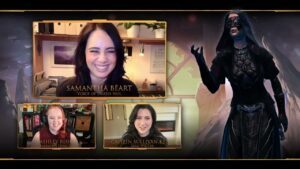A bold and risky pivot toward action for Square Enix’s beloved RPG franchise, Final Fantasy XVI is a stunning achievement that revitalizes the series for a new age—and it just may be the best the series has been in more than 20 years.
In an era when so many developers try to emulate the open-world immersion mastered by Nintendo with recent Zelda games, FFXVI opts for something more linear that makes room for a thrilling episodic story chock full of epic action set pieces and tender moments between lovable characters.
Design-wise, it feels a bit like a PlayStation 2-era game with its world map and individual zones, but the power of the PlayStation 5 delivers world-class cinematics for a story unlike any other. Final Fantasy XVI feels just as sprawling and even more immersive than your average “open world” thanks to dynamic environments and a large number of side quests delving into the people of Valisthea. But best of all, the care and attention to detail captures that special something that defines Final Fantasy.
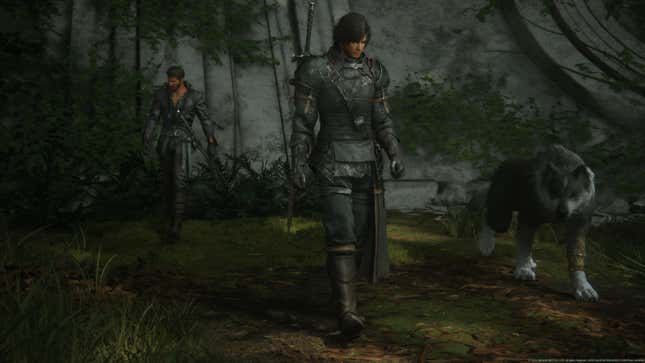
It confidently wields subtle gestures to flesh out how broken people manage in a dark world where magic’s influence is both a blessing and a curse. Whether it’s the tender caress of a lover or a playful jab at a brother’s chest, intimate moments even out the blistering and occasionally bombastic pace of the main story.
What’s Final Fantasy 16 about?
A corrupting Blight plagues the once resplendent world of Valisthea, pushing six nations toward war over the massive Crystals the people rely on as a source of magical energy. You play as Clive Rosfield, the eldest son to the Duke of Rosaria, sworn to serve as his brother Joshua’s protector. Joshua, like a handful of other individuals in this world, is a Dominant who serves as the host for the Eikon Phoenix, an otherworldly being of unimaginable power. For the more feeble Joshua to be the host of Phoenix is an unpleasant complication for pretty much everyone involved. His mother despises Clive for this twist of fate with her Malfoy-esque commitment to blood purity.
At least Clive gets a cute dog named Torgal. And his father’s love.
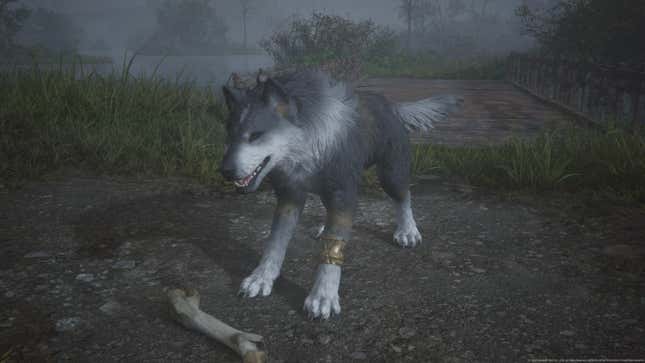
A tragic event puts Clive on a path of vengeance as he aims to free humanity from the quarrelsome legacy of the crystals, and we follow his journey across three different time periods as he fights and channels the power of the world’s Eikons.
Like the best Final Fantasies, XVI explores how trauma shapes heroism and what it takes to persevere against impossible odds. This is a dark, mature story. But that just means the light shines that much brighter when good people fight for what’s right.
Final Fantasy XVI may seem like it’s cosplaying as Game of Thrones, but it’s far more inventive than iterative in that regard. Producer Naoki Yoshida previously confessed that the game’s initial core development team watched the entire HBO series so they might capture the more Western “feel” of Westeros. This largely consists of things like overt parallels between the Rosfields and the Starks, and how much the Clive-Torgal dynamic resembles that between Jon Snow and Ghost. There’s even a guy so much like Hodor that it inches towards cringe.
Your concerns that this may be just an empty imitation of that saga, however, will quickly fall away.
FFXVI treats GoT with reverence and skepticism in equal measure. For every detail that seems to pay rote tribute to the series, there’s a way in which this game goes in a thematically different direction, its narrative focus on humanity and tenderness ultimately functioning as a kind of critique of Game of Thrones’ nihilism.
Forget the pointless incest and torture porn. FFXVI tells a far more meaningful, refined, and unequivocally better story that’s bursting with heart. Everything we love about Game of Thrones—the political scheming, epic conflicts, thrilling combat, and mature tone—is here. But while Westeros is a miserable place for miserable people where there’s very little magic, Crystals and Dominants mean Valisthea is dripping in the stuff. It’s a sick and dangerous place full of people desperate to heal and free themselves from the corrupt powers controlling everything. To do that, characters take a Ted Lasso approach to earnest intimacy. They don’t always fight to save the world. They fight to save their loved ones.
For all her talk about “breaking the wheel,” Daenerys Targaryen did no such thing. Clive, however, is on a much more satisfying journey to destroy the status quo established for generations by the crystals.

Imagine if a handful of individuals inherited the power of a god. How would that define entire nations and families? How might the political schemers of the world manipulate such beings for their own gain? How many Dominants would wield their power as a tyrant? And that’s to say nothing of the Bearers, people randomly born with low-level magic powers that society treats as slaves. They’re labeled as “Branded” at a young age due to forced, poisonous face tattoos. Then they spend a lifetime draining their own life force using magic to keep fires roaring for the privileged only for their entire body to crystallize.
Final Fantasy XVI devotes a lot of time to the plight of the Bearers, perhaps because Clive himself bears the Brand. They’ve been subjugated for so many generations that cruelty against them is ingrained in all of the Valisthean cultures. Most are enslaved and treated as second-class citizens, and plenty of religious zealots see them as a sin against nature that need to be purged. Magic is at the root of all cruelty, and Bearers suffer from it the most.
Bearers are people unlucky enough to have been randomly born with magic, and because just about everyone in this game’s world is white, most Bearers are, too. The way the Bearers serve as a kind of commentary on real-world systems of oppression is obvious, but at the same time, the overwhelming whiteness of the game’s world does make it feel somewhat detached from any such real-world concerns.
Valisthea has relied on the Crystals, Dominants, and Bearers for so long that magic feels like the only real currency in this post-capitalist dystopia. Trauma lurks around every corner, but rather than despair, FFXVI explores how people persevere and heal in spite of it all.
As in so many Final Fantasy games, these terrestrial concerns eventually give way to more cosmic conflicts, and the grand scale of XVI’s mythos is one of the most interesting in franchise history. Even the most diehard fans who’ve seen every FFXVI trailer will have no idea what’s coming.
Clive’s quest leads him into the orbit of Cid the Outlaw, FF16’s resident charming rogue with a heart of gold. Actor Ralph Ineson’s performance as Cid is an all-timer, making Cid’s lofty ideals and roguish charm feel rooted in a lifetime of lived experience. He never wastes the opportunity to light up another far too-long cigarette using magic, nor does he ever refrain from delivering bits of wisdom with his gruff and gravely accent, thick with years of regret. He’s the beating heart of this story from start to finish, and Ineson’s Cid is an absolute scene-stealer who’ll go down in history as one of the best Final Fantasy characters ever.
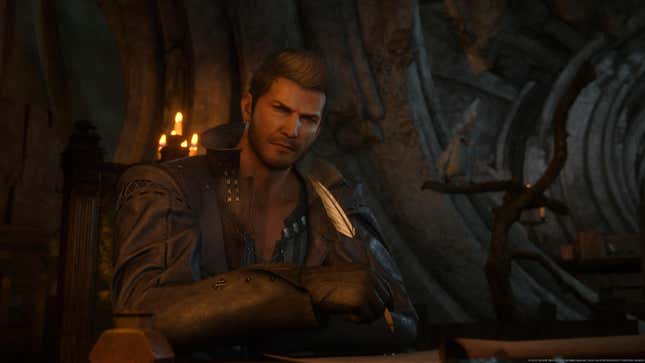
But there really isn’t a weak link in the cast. Lead Ben Starr is pitch perfect as Clive, capturing a straightforward and earnest gravitas that somehow makes for a likable edgelord.
If there’s a fault to be had, it’s in Valisthea’s lack of diversity. Producer Naoki Yoshida told IGN in November 2022 that the design concept always focused on the “historical, cultural, political, and anthropological standards” of medieval Europe. In other words, these cultures are mostly different variations on familiar-looking white medieval patriarchies like Transylvania or England and represent only a small corner of this world. The game’s Dhalmekian Republic, admittedly, is coded as Middle-Eastern. Yet the Dhalmekian Dominant of Titan, Hugo Kupka, appears Caucasian. The core cast therefore becomes overwhelmingly homogenous.
A more meaningful approach to diversity does not seem too outlandish in a world where a little blonde boy can transform into a giant bird made of fire.
FF16’s Combat
Final Fantasy XVI marks a radical departure from the series’ traditional game mechanics, but its heavy emphasis on action feels like a natural evolution that’s been a long time coming. Everything since Final Fantasy X has inched away from the turn-based strategic combat of the classic games, and XVI takes a risky leap that absolutely delivers—especially if you’ve ever dreamt of sucker-punching a Chocobo in the stomach.
Combat feels like a smattering of Final Fantasy VII Remake, Kingdom Hearts, and the Nier games in equal measure but with a faster pace, but there’s also a lot of DNA borrowed from The Witcher and classic God of War games. In practice, this means that you wield Clive’s greatsword in combat, dodging and parrying enemy attacks, unleashing powerful Eikonic abilities with cooldown timers, and occasionally transform into a colossal, hugely powerful Eikon. FF7 Remake’s “Stagger” combat mechanic plays a huge role here as well, encouraging you to go all out during a narrow window where you deal bonus damage.
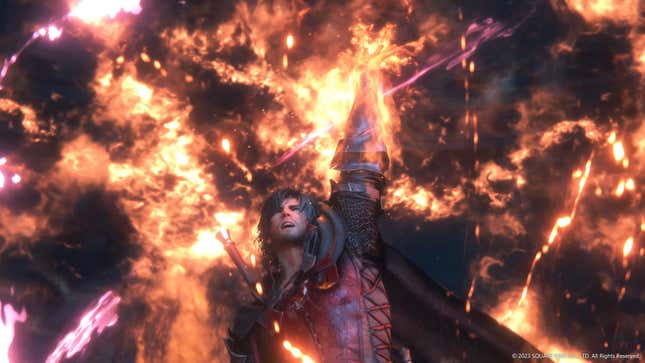
Timed dodges and parries are just the start of the wide variety of abilities at Clive’s disposal. Modest skill trees allow Clive to unlock only a few abilities for each Eikon, and he can equip up to six total from the different trees, all mapped to the same button combos. Hold R2 and press triangle, and you might sweep a Phoenix wing upwards in a wicked uppercut. Final Fantasy’s classic Limit Break mechanic—a powerful attack charged by taking and dealing damage— appears in XVI as Clive powering up to a “Semi-Prime” state which is functionally identical to Kratos’ Rage, both in its fiery aesthetics and in its capacity to replenish health.
As Clive shuffles between the magical powers of the various Eikons he’s channeled, he’ll occasionally scream out their name in the heat of battle. “Garudaaa!?” he cries out in a fit of desperate panic as he summons the air harpy’s massive claws to rip away at enemies. It seems like the tone is ever so slightly different depending on how the battle is going, which is a welcome level of detail that makes things feel that much more believable.
Combat in Final Fantasy XVI has a fierce, blistering energy that makes it hard to put down. Epic little flourishes like Clive calling out to specific Eikons only enhances the simpler, more rhythmic flow of battle. Because there are no element type advantages at play and a wide variety of abilities at your disposal, XVI caters to many different playstyles.
The item economy, however, feels a bit undercooked at times. Most of the loot you collect around the overworld and from battles consists of ubiquitous items like a stone called Wyrrite or your run-of-the-mill Sharp Fang. They’re used to craft and upgrade gear, but it all feels very standard and obligatory, crafting for the sake of crafting, and eventually lugging around thousands of Bloody Hides starts to feel a bit silly.
A high point for the RPG series
Over the course of the 70 or so hours it takes to beat the game, Final Fantasy XVI tells an episodic story about the roles played by Valisthea’s various Eikons.
There’s a formula at play: Explore a new region of Valisthea, encounter a local kingpin, make them your lifelong friend, and run a bunch of errands for them before you go fight a god. Along the way, you’ll get to know different people and deal with whatever problems the latest Dominant is causing. The inevitable brawls against each Eikon make for some of the greatest spectacles in modern gaming.
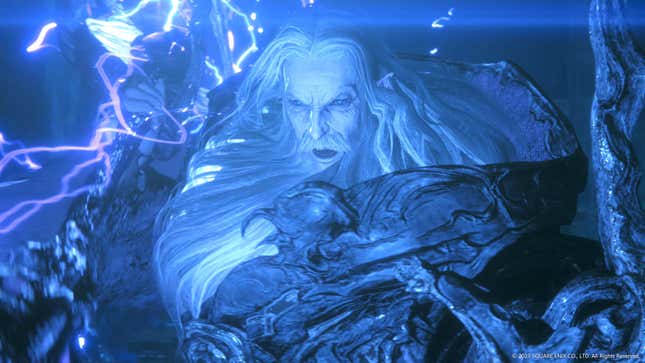
Each Eikon’s Dominant, however, ends up being a uniquely tragic figure that’s as much victim as they are demigod. Their time in the rotating spotlight makes the whole affair feel like you’re watching multiple seasons of a TV show. Garuda’s Dominant Benedikta emerges quickly as an Act 1 villain who uses magic to vape in her very first scene. She’s a woman who leverages her power and sexuality to her advantage. At first, she may seem like a familiar and tired stereotype. Like every major character, however, there’s so much complexity simmering beneath the surface.
Dominants “Prime” to summon their Eikon, channeling a great deal of magical Aether at the expense of taxing their body, and the “Semi-Prime” state is a lesser version of this that enhances their natural abilities (Clive’s Limit Break). There is no greater thrill than Semi-Priming to butcher a pair of bandits trying to rob a lovely innkeeper of her coin.
FFXVI gets Very Anime with all of the powering up and down, and somehow it never gets old. As Ifrit, Clive can hurl fireballs like Goku shooting a kamehameha, but the beast is as fast as he is strong, climbing entire mountains to reach his more mobile enemies. And because each Eikon is the warden of a different element, these encounters present vastly different challenges. Titan, for instance, absolutely towers over you and he can control the very earth, so facing him is quite unlike confronting the others, each spectacular in their own way. No two battles between Eikons are the same, but each one could very easily destroy an entire city if it happened in the wrong place.
Beyond these more worldly concerns is a more cosmic conflict lurking behind the scenes, one that contemplates the meaning of existence by delving into the abstract and metaphysical. What are we without free will and consciousness? Does free will enslave us to desire and pain? How important is it to pursue our dreams? In asking these big questions, Final Fantasy XVI ultimately manages to say something genuinely insightful about identity, connection, and embracing the vast mystery of existence while celebrating the power of the human heart. I can’t help but wonder how much of an influence Neon Genesis Evangelion was here.

For all it invests in big-scale brawls between Dominants, the game also leans into quieter human connections. Many of the side quests are almost too simple: Go to this place marked on the map, listen to somebody talk, kill some bandits, get a bunch of bloody hides as a reward. But there are so many exceptional vocal performances and well-written arcs that you can’t help but come to love this world as much as Clive does.
Show up for the kaiju fights, but stay for the tender series of quests exploring the complicated and noble backstory of your hideout’s resident blacksmith.
What does it mean to be a Final Fantasy?
In a May 2023 interview with Push Square, Yoshi-P reflects on what defines the series:
“My answer is simple,” he said. “You need to have the best story, you need to have the best graphics, you need to have the best battle system, you need to have a lot of content, you need to have the Chocobos, you need to have Moogles, you need to have great sound, and that makes a Final Fantasy. And if you’re missing even one of them, the fans will hate you forever.”
At the time, it felt like a cheeky admission that you can’t make everybody happy, and yet, against all odds, Final Fantasy XVI delivers all of the above in spades.
Yoshi-P himself has admitted that the series is “struggling.” And while it’s tremendously underrated, Final Fantasy XV is a far cry from the series’ glory days of the ‘90s. It reminds me of the position Hironobu Sakaguchi found himself in during the ‘80s at Square: He poured his heart and soul into making one final game for a studio on the verge of bankruptcy, and they called it Final Fantasy.
For the first time in years, I’m excited about a new mainline Final Fantasy game. It’s about time.
If you’re getting into Final Fantasy XVI, you’ll want to have check out our 15 critical tips to know before jumping in, as well as make sure you know the best early abilities to unlock and upgrade.
